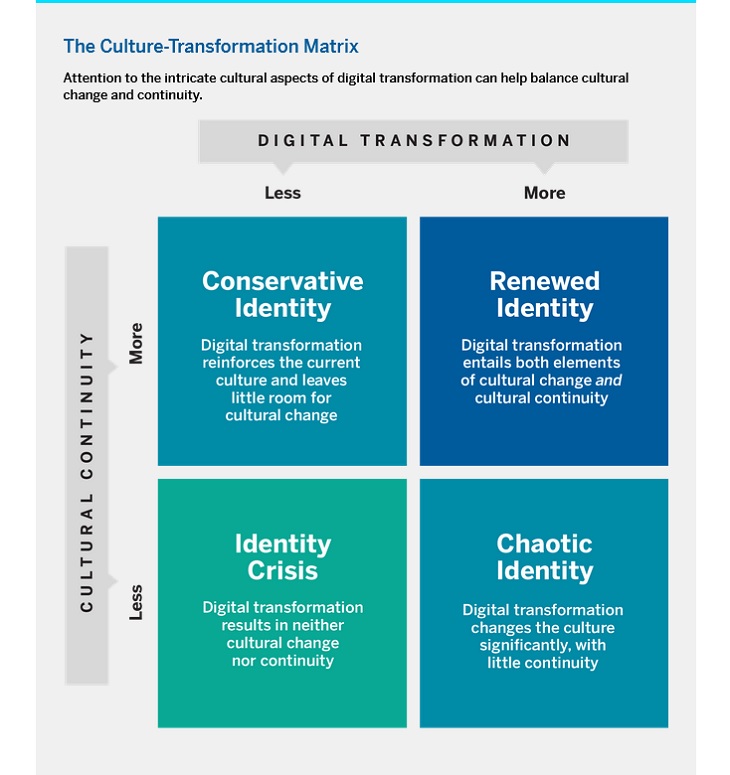Framework 125 Cultural-Transformation Matrix
Introduction
The intricacies of an organisation's culture play a critical role in the successful implementation of digitalisation in an organisation.
"...the biggest component of digital transformation is the cultural change that goes along with it. It's good to have strategy and technology that will enable it, but the hardest work is around culture, re-education and upscaling of the organisation..."
Doug Straton as quoted by Carsten Lund Pedersen, 2022
To become digitalised, many organisations have become tech organisations. This can pose cultural problems as the IT people see digitalisation through their technical lens, ie cultural change (refers to digital transformation that may alter an organisation's culture); while the operational people see it through a cultural continuity lens (refers to elements of the culture which remain stable). Both lens need to coexist for the change to be successful, ie develop the right balance.
"...change without continuity results in chaos, while continuity without change results in conservatism..."
Carsten Lund Pedersen, 2022
However, most digital transformation initiatives emphasise cultural change at the expense of cultural continuity. This creates problems for digitalisation that can result in a failure.
Matrix
This involves cracking the cultural code for successful digital transformation, ie getting the right balance between cultural change and continuity. Consequently, understanding the play between 4 elements in the below matrix is vital:
i) identity crisis ('low' cultural change and continuity aspects can cause a corporate identity crisis; this can make a transformation initiative difficult as the process is not grounded on a solid foundation; however, this can mean the organisation is not impacted by pre-existing beliefs that can impede the digital transformation, ie gives the organisation a chance to create a strong corporate identity that incorporates digital technologies into their business model and value propositions plus creates a culture which includes digital literacy and familiarity with AI, data science, social media, etc. Examples of the situation are 'start-ups' as they are new, ie no cultural continuity, and just starting the journey of cultural change; they need time to find their niche in the market and develop digital capacity; it is interesting to note
"...around 36% of small businesses in the US don't even have a website..."
Carsten Lund Pedersen, 2022)
ii) chaotic identity (digital transformation change in culture to significantly, with little continuity, chaos will result, ie
"...change necessitates a cultural basis on which to emerge; without such a basis, the resultant change will likely be too fragmented and detached to make sense to members of the organisation..."
Carsten Lund Pedersen, 2022
Need to have the change built on the current and historical operational culture of the organisation. Otherwise,
"...Digital transformations often fail by having too much change and too little consistency..."
Carsten Lund Pedersen, 2022)
iii) conservative identity (
"...if digital transformation reinforces the current culture and leaves little room for cultural change, the end result will likely be cultural dogma and inertia..."
Carsten Lund Pedersen, 2022
Organisational culture can hide recognition of its own 'outdatedness'. This can result in the organisation becoming obsolete like Kodak, Blockbuster, Nokia, etc
"...Nokia had a strong cultural belief in its own core strengths of product functionality and a device-centric operating system, but it overlooked the move toward software, platforms and ecosystems made better by Apple, which showcased its ground-breaking iPhone device and iTunes and App Store platforms. Nokia had initially become a market leader due to its innovative device technology, so it continued to repeat what had worked in the past - until it became painfully clear that it had missed the market shift from devices to platform......ultimately, Nokia lost out to Apple due in part to its conservatism - an overreliance on cultural consistency at the expense of cultural change..."
Carsten Lund Pedersen, 2022)
iv) renewed identity (combining elements of cultural change and cultural continuity to give sustainable renewalThis that secures corporate longevity, ie
"...while some elements will change and adapt to the new digital reality, these change initiatives are sufficiently rooted in the pre-existing culture to ensure cultural continuity......The end result is a digital transformation that operates in accordance with the experience and understanding of organisational members..."
Carsten Lund Pedersen, 2022
An example is IBM
"...Founded in 1911, IBM 's long history and traditions manifest in a strong corporate culture characterised by professionalism, reliability and technological innovation. IBM has stayed at the forefront of multiple technological waves and transformed itself to adapt to a market that has evolved from early computing to the Internet era of digital services, blockchain and AI. It has successfully and continually changed its business model to align with technological developments, adapting its culture - for example, by creating a service emphasis supportive of its service business - while simultaneously maintainingWill it core cultural values on which it was founded......be willing to change everything but who you are..."
Carsten Lund Pedersen, 2022)

(source: https://sloanreview.mit.edu/article/cracking-the-culture-code-for-successful-digital-transformation)
